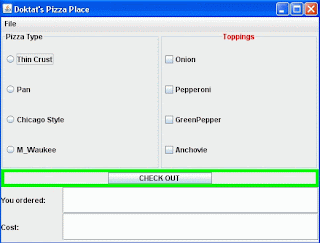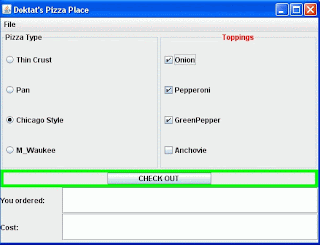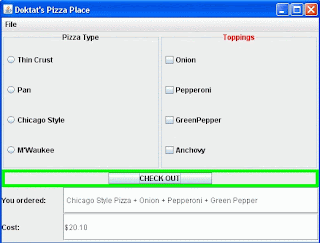 The user selects the type of pizza from the radio buttons on the left and with the use of the check boxes on the right, indicates the desired toppings. In the schematic below, the user has selected a "Chicago Style" pizza with onion, pepperoni and green pepper toppings but the "CHECK OUT" button hasn't been clicked yet.
The user selects the type of pizza from the radio buttons on the left and with the use of the check boxes on the right, indicates the desired toppings. In the schematic below, the user has selected a "Chicago Style" pizza with onion, pepperoni and green pepper toppings but the "CHECK OUT" button hasn't been clicked yet. When it's time to check out, the user clicks on the "CHECK OUT" button and the text field below the button presents the user with the style of pizza and toppings included in the order. The text field below that shows the cost. The cost was determined by summing the costs of the individual
When it's time to check out, the user clicks on the "CHECK OUT" button and the text field below the button presents the user with the style of pizza and toppings included in the order. The text field below that shows the cost. The cost was determined by summing the costs of the individual
components used to create the pizza object which was: Chicago Style Pizza = $16.50; Onion = $1.15; Pepperoni = $1.25; Green Pepper = $1.20. Another requirement of the application is that after the "CHECK OUT" button has been clicked, the check boxes and radio buttons have been cleared and are ready for another pizza selection. Also, the user must be able to change their mind about toppings before the "CHECK OUT" button has been clicked. For example, if the user had already selected the "Anchovy" check box and then decided to delete the Anchovy selection, another click on the "Anchovy" check box will toggle off the selection.
A solution to Programming Without Ifs: Challenge Five will be discussed in a subsequent blog.

No comments:
Post a Comment